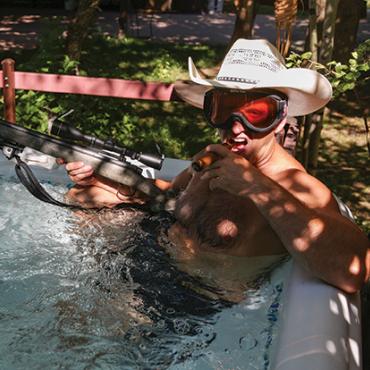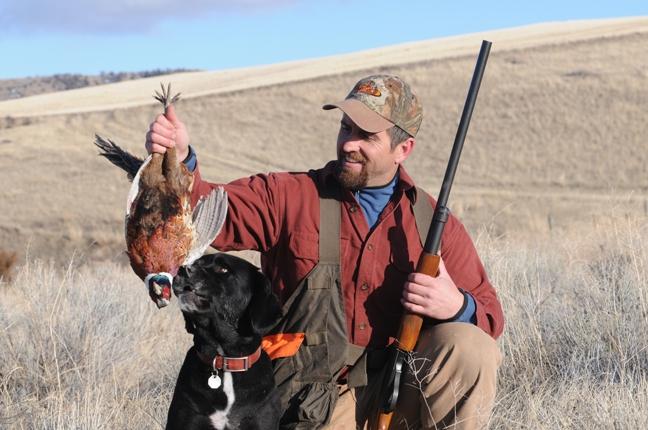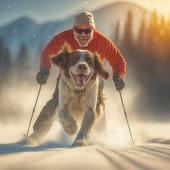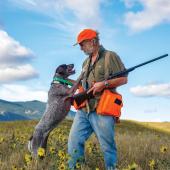Of Mutts and Men
Fanning out across the field, a dog in front of each of us, we move slowly, deliberately, through the hayfield’s saffron stubble. It’s late morning in the lower Madison Valley; the sky is clear and bright, with a cool, persistent breeze. Perfect hunting weather. We angle into the wind, giving the dogs the best possible approach for picking up scent.
We’re focused, alert, and intent—there are birds out there, somewhere, hunkered down in large swaths of shin-high growth. None of us in our well-armed hunting party—four men with big guns, four dogs with strong noses—can totally relax until at least a few of them are in the bag.
None of us except Cole, that is, who’s bounding across the field like a drunken Billy goat. Lost in the aimless enthusiasm of canine youth, he’s oblivious to our ordered movement. We whistle, we yell, we scold, to no avail. It’s playtime and this field is the playground; he’ll run as he pleases. There’s a reason my brother calls his 10-month-old, 100-pound Lab/Newfie cross “FSG”—he’s a Full-Speed Galoot.
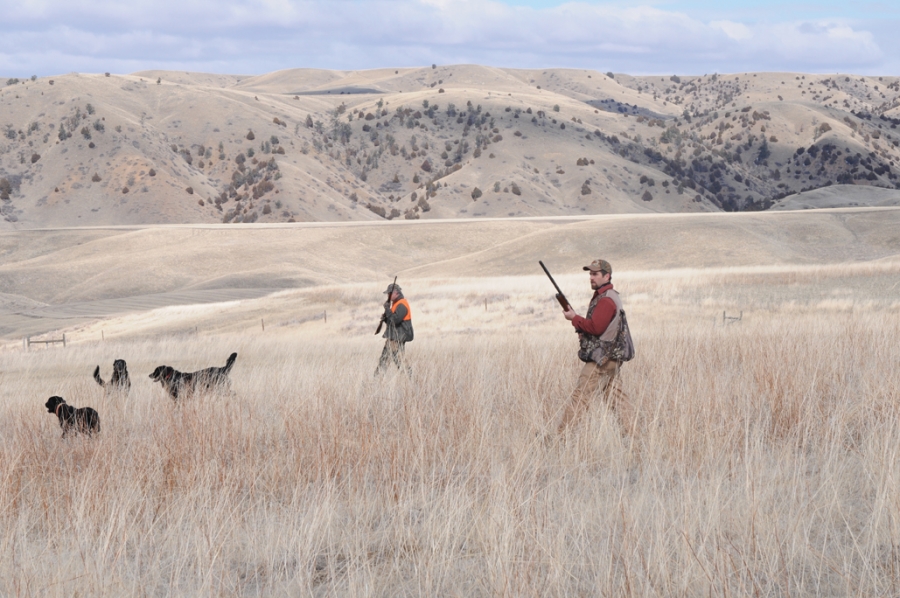
Despite the disruption, our veteran mutts Cosmo and Rico manage to get a few birds up. Kent knocks the first one down; Jim bags another with an impressive long-distance shot. And then it happens: Cole stops dead in his tracks, lowers his snout, and takes several short, frenetic sniffs. Nose to the ground, he sweeps behind me and dives into a lone clump of bunch grass. In an explosion of wingbeats, a pheasant breaks skyward. I turn and shoot; the bird drops to the ground. Cole snatches it up and runs over to me, his enormous black frame bristling with excitement. I coax him gently to hand over the pheasant, then unleash a deluge of affectionate praise: “Good boy! What a flush! You’re a huntin’ dog now!” He’s beside himself, wagging his tail proudly and licking my face. And when we turn to resume the hunt, he’s a new dog: restrained, purposeful, attentive to his surroundings. He’s a member of the team now, a part of our collective effort, and he knows it.
There’s no doubt that Grey Cliffs Ranch–the sprawling, 5,200-acre game preserve near Buffalo Jump State Park that we’re hunting on today—has helped initiate dozens of budding bird dogs. But for our group of weekend wingshooters, each one is special. Like us, our dogs are not purebreds, expertly trained and bred to hunt. Each one is a mutt, a mixed-blood mongrel born not of championship bloodlines but of happenstance; chosen by us not for his AKC registration, pedigree, or “impeccable angulation,” but for his cuteness, cuddliness, and laid-back disposition. The only papers we have are the occasional vet bills; the only training they get is in the field, during the hunt. Our dogs are companions, first and foremost, and the fact that they can hunt is a bonus: an unexpected and wonderful gift. Like discovering your child is exceptionally bright, or that your new girlfriend owns a beach house in Mexico. It’s icing on the cake.
After a few more birds, we stop at the lodge for a water break. The dogs cool off in the pond while we relax on the deck. We watch a herd of mule deer grazing on a nearby hillside. Above a distant hayfield, a red-tailed hawk floats 20 feet off the deck, riding updrafts and scanning the field for prey. Chris, the ranch manager, tells us about a lone black wolf that’s been roaming the ranch lately. We’d already spotted coyote and fox tracks, as well as plenty of elk sign; what other sights await us in this zoological oasis?
We head back out. Cresting a knoll, we take in the arresting panorama. Sage-flecked hills spread eastward in fold after fold of wild, unbroken country. Rugged, juniper-choked draws spill in from above the lodge. To the south lie vast hayfields, and far beyond rise the jagged Spanish Peaks. The long, undulating spine of the Tobacco Roots forms our far western flank. In their shadow flows the mighty Madison River and its array of riparian life. This is big, beautiful country; it’s easy to forget about the hunting and just enjoy the views.
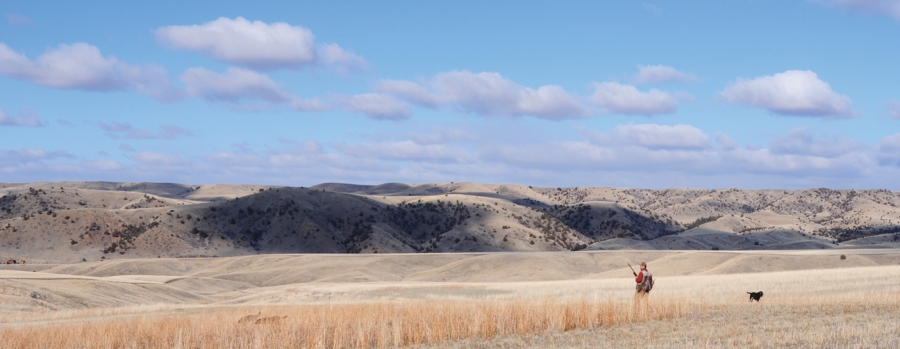
But the dogs are in the zone now, and their rapt, controlled demeanor reminds us that there’s work to do. Cosmo, Kent’s Labrador retriever / Australian shepherd cross, has overcome his initial hysteria and settled into a smooth, deliberate rhythm. Conversely, mellow old Rico, my own canine blend of Lab, retriever, and who-knows-what-else, has energized more with each bird flushed. Even Amigo, Jim’s moose-sized retriever mix, has abandoned his independent streak and started working with the other dogs. Cole watches and tries to imitate their movements.
“Cosmo’s getting birdy,” Kent calls out, and we all turn, bringing our guns to the ready position. It’s often a false alarm, but this time Cosmo’s rushing around like he just lapped up a bowl of Red Bull. Rico’s hunted with ‘Mo long enough to know what that means; he falls in behind and his body tightens as he, too, picks up the scent. Their motions become increasingly intense and frenzied; their tails jerk spasmodically as they dash about trying to trace the scent to its source. In a rush of flapping wings, a cock pheasant shoots skyward. A strong crosswind grabs the bird and whisks him away from us—we all shoot at once, and the bird tumbles into the sagebrush. Cosmo gets there first and proudly trots back to his master, the colorful pheasant dangling from his mouth.

The day goes on, and as the sun nears the horizon, the dogs manage to flush a few more birdsl. By the time we wrap things up, every dog has flushed a few birds, and every man has shot at least two. It’s been a good day for the Montana mongrel crew.
Not that we’ve ever had a bad one at Grey Cliffs. As a private game preserve, it sees far fewer hunters than most ranches. Our group typically buys 20 pheasants, which Chris then places in various locations around the ranch. A healthy resident population means the dogs generally flush another half-dozen pheasants, plus several chukars and Huns. It’s pretty much guaranteed action, which is what makes it such a great place to bring young dogs, as well as a means to keep the older dogs sharp. Dogs are like people: a lack of action makes the attention wander.
It’s also a place for a bunch of hacks like us to have a good time shooting pheasants. Unlike our more serious bird-hunting brethren, we don’t take regular, week-long trips to eastern Montana and North Dakota, our trucks loaded with kennels, shock-collars, and shotguns that cost more than my truck. Our dogs miss birds, and occasionally fail to bring them to hand. And we miss as many as we shoot, watching sheepishly as the pheasant flies off unharmed. But we’re spending time with friends—both canine and human—and learning a little bit more about bird-hunting each year. We hunt harder, smarter, better. And we’re connecting with our dogs in the process.
With a half-hour left before dark, we head to the sporting clays course to practice our shooting. Five stations offer a range of scenarios—on one station, the clay pigeon flies directly overhead; on another, it speeds by so fast it’s a blur. Peter turns out to be a clay-shooting deadeye, nailing some of the hardest shots. For some reason, he refuses to boast and laugh at all of our misses. We sure wouldn’t show him the same courtesy.
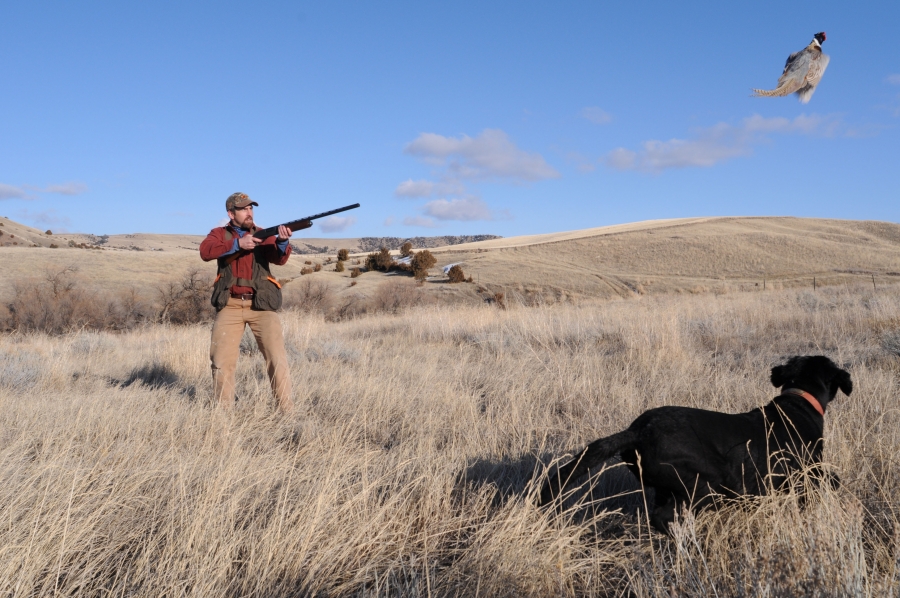
Now it’s dinnertime. We clean the birds, then feed and water the dogs before jumping in the truck and heading to Willow Creek Café. The sassy waitress cajoles us as we devour fat steaks and dark beers. We raise our glasses to one another and relive the day. Every one of us feels lucky to live in Montana, where we can spend a long day in the hills and fields with our dogs, breathing the clean Rocky Mountain air and experiencing the magic combination of human and natural, that includes our dogs.
Back at the lodge, we flop down in front of the fireplace. Kent breaks out his banjo and strums a tune. The rest of us tap our feet and watch the shooting stars while coyotes yip in the distance. And we fall asleep to the sound of nothing—no cars, no trains, no background noise whatsoever. Nothing but the quiet beauty of the Montana landscape, and the calm reflection of a good day in the field.

